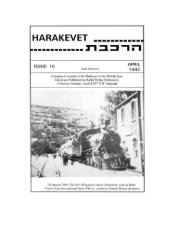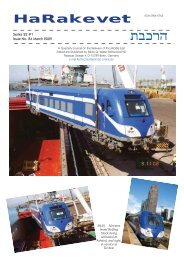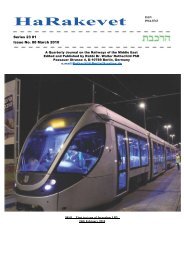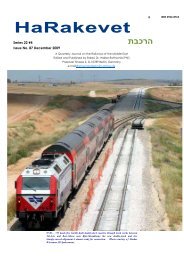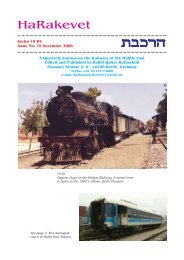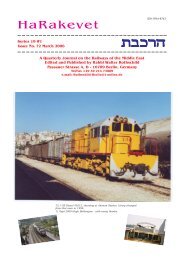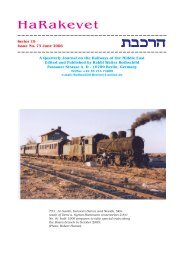Create successful ePaper yourself
Turn your PDF publications into a flip-book with our unique Google optimized e-Paper software.
(c). HANS KOHUT.<br />
A note that should have appeared<br />
much earlier. Back in January 2004 Hans Kohut<br />
of Givatayim wrote a touching ‘farewell’ - of<br />
the sort that makes the Editor both sad and<br />
proud. “I am no longer mobile and therefore<br />
entered a local nursing home for Parkinson’s<br />
Disease patients, for the rest of my life. My<br />
only connection with the Railway is now with<br />
Paul by phone and with Benny and Yaniv in<br />
the Tel Aviv Rail HQ. But even phone communication<br />
is not easy at all! So, ‘Harakevet’<br />
will my my ‘chief informant’ until I leave this<br />
planet for good. My best thanks in advance<br />
for everything in my remaining years....”<br />
For those who never knew him -<br />
Hans was one of the ‘pioneer’ railway enthusiasts<br />
in Israel in the time when one needed<br />
a lot of patience to await a train at all...... his<br />
late brother Ernst was, by enormous coincidence,<br />
a member of my congregation ‘Sinai<br />
Synagogue’ in Leeds when I served there<br />
1984-1994.<br />
(d). SEJED STATION.<br />
Back in 2001 Peter Smerdon of<br />
Basingstoke sent me a page (p.14) from the<br />
Baedecker Historical Palestine guide book of<br />
1<strong>91</strong>2. This describes the route by train from<br />
Jaffa to Jerusalem:-<br />
“25 Miles: Sejed. The station is situated in an<br />
insalubrious but fertile plain. From Sejed the<br />
line follows the depression of the Wâdi es-<br />
Sarâr (the ‘valley of Sorek’; Judg. xvi.4), which<br />
is wide at its mouth, but afterwards narrows.<br />
Beit ‘Atâb, situated on the top of the hills to<br />
the left, remains for some time in sight; farther<br />
on, also to the left, the weli of Sar’a (the ancient<br />
Zoreah, Josh. xv.33, xix.14; Judg. xiii.2).<br />
To the right lies the deserted village of ‘Ain Shems<br />
(the ancient Beth Shemesh, 1 Sam. vi.9;<br />
1. Kings iv.9), where excavations are now<br />
being carried on by the Palestine Exploration<br />
Fund. A megalithic wall, dating from the Israelite<br />
kingdom, with a well-preserved gate<br />
(S.) and quadrilateral bastions has been laid<br />
bare nearly in its whole circuit. Pottery of the<br />
same period as well as of pre-Israelite times<br />
(imported from Cyprus and Crete) has also<br />
been found. Farther to the S., on the hill, is<br />
Beit el-Jemâl (agricultural college of the Salesians).<br />
31/2M. Deir ‘Abân; the station is<br />
about 3M. distant from each of the three villages<br />
that are served by it; Deir ‘Aban (to the<br />
S., not visible), Sar’a (see above), and Artûf, a<br />
colony of Bulgarian Jews (pop. 95) founded<br />
in 1896, a little below Sar’a. Sar’a and Artûf<br />
are seen on a hill to the left. The mountains<br />
now begin. Shortly after entering them we<br />
see high up in the rocks to the left the mouth<br />
of a grotto, the so-called Samson’s Cavern<br />
(the story of Samson is localized in this district;<br />
Judg. xiii-xvi). The line passes along precipitous<br />
walls of rock and ascends the windings<br />
of the Wâdi es-Sarâr. We pass (38 1/2M)<br />
Page 16<br />
Deir esh-Sheikh, on a hill to the right, and (40<br />
1/3M) ‘Akûr, on a hill to the left; beyond it, the<br />
Wâdi Kalôniyeh opens on the left. The line<br />
continues to follow the Wâdi es-Sarâr. On a<br />
hill to the right is the village of (46M) Bittîr.<br />
47 1/4M. Bittir. The Baither of Joshua<br />
xv.59 in the Septuagint (Beth-arabah of Josh.<br />
xv.61 in the A.V.), or Bethar, played an important<br />
part in the insurrection of Bar Cochba<br />
against the Romans... The latter succeeded in<br />
capturing it only after a siege of 3 1/2 years<br />
(A.D. 135), when a terrible massacre of the<br />
inhabitants ensued.”<br />
(e). NEW RAILWAY ATLAS OF NORTH<br />
AFRICA.<br />
Neil Robinson writes that ‚World Rail<br />
Atlas Vol. 7 - North, East and Central Africa‘<br />
is now available - „It is exactly the same A4<br />
landscape soft-back format as the last publication.<br />
The layout of the book is very similar,<br />
although I have made a few format refinements<br />
to generally improve the appearance.<br />
I am selling it at £25.99 plus GBP<br />
5.10 postage to all European addresses (or<br />
GBP 2.20 postage to UK). You will especially<br />
be interested in the Egypt coverage. Paul Cotterell‘s<br />
studies and maps of the WW1 trench<br />
railways of the Sinai were very useful indeed.<br />
But only large scale research uncovered exactly<br />
how many narrow gauge railways had<br />
existed in Egypt, and how many more I failed<br />
to research fully, and how many I have (no<br />
doubt) missed altogether.“<br />
The book can be ordered from<br />
Neil at: 1, High View Close, Darfield, Barnsley,<br />
South Yorkshire, S73 9AR. He has supplied<br />
me with a copy which is very much up to the<br />
standard of the previous volume and is highly<br />
recommended!<br />
(f). THE GRAVE OF GEORGE SYKES<br />
IN HAIFA.<br />
Michael Gottschalk of Haifa has<br />
been pursuing his researches indefatigably,<br />
coming up with a few dead ends but, with<br />
the help of others, often stumbling upon useful<br />
information. In addition the Palestine Police<br />
Old Comrades Association has offered<br />
to help sponsor the refurbishment of an appropriate<br />
headstone. Here is just a digest.<br />
In the 1901 London Census is a<br />
George Sykes aged 33, i.e. born about 1868<br />
in Clapham, London, and married to Frances<br />
Sykes (27 at this time). He is described as<br />
‚Works Manager, Telegraph Engineering‘ and<br />
the Household included Diana Smith (60)<br />
(possibly maid/cook? Or Francis‘ mother?);<br />
Rose Botwright (16) - (possibly housemaid)<br />
and children George (3), Marie (2) and<br />
Dorothy (11 months). The family is for some<br />
unknown reason not found in the 1<strong>91</strong>1 census.<br />
In December 1928 a George Sykes<br />
married a Doris Clarke at Marylebone, London.<br />
,cfrv<br />
It is now known that George Robert<br />
Hughenden Sykes was born 19th. April<br />
1897, at Barrington Road, Brixton, Lambeth,<br />
London; He attended Dulwich College and<br />
when World War 1 broke out joined the East<br />
Kent Mounted Yeomanry. After the war he<br />
joined the Great Eastern Railway Company at<br />
Stratford, became a member of the Institute<br />
of Mechanical Engineers and in 1926 transferred<br />
to Palestine Railways. (This has made<br />
matters complicated because he was not in<br />
the military any more when killed in 1929 and<br />
therefore the Commonwealth War Graves<br />
Commission is not responsible for maintenance<br />
of the grave.) We also know why he<br />
could not be found in the lists of the Royal<br />
Engineers!<br />
In the ‚Journal of the Institute of Locomotive<br />
Engineers‘ Vol. 19 (1929) p. 831 is an Obitu-<br />
ary:-<br />
„Mr. George R. Hughenden Sykes<br />
met his death on the rioting that took place<br />
on the 25th. August last in Palestine. His duties<br />
at Haifa as Locomotive Running Superintendent<br />
of the Palestine Railways no doubt<br />
made him a marked man in the movement of<br />
troops, and the rioters ‚stoned him to death‘<br />
literally.<br />
Born in 1897, Mr. Sykes was educated<br />
at Dulwich College and at the outbreak<br />
of the Great War in 1<strong>91</strong>4 volunteered for service,<br />
joing the East Kent Mounted Yeomanry<br />
in August of that year.<br />
After training at Herne Bay, Crowborough<br />
and Blackdown (Aldershot) camps<br />
he was drafted overseas attached to the<br />
57th. West Lancashire Division, 170th. Brigade<br />
in France, being for most of the time a dispatch<br />
rider in the ‚Signals‘. He remained in the<br />
army until 1<strong>91</strong>9, and notwithstanding some<br />
exciting experiences, received no wound, in<br />
striking contrast to the method of his death<br />
during a so-called peace time occupation in<br />
Palestine.<br />
After leaving the Army he underwent<br />
locomotive-shop training at Stratford,<br />
and in the Running Department of the former<br />
Great Eastern Railway under the late Mr. Hill,<br />
Locomotive Superintendent, joining the Palestine<br />
Railways as Locomotive Runing Superintendent<br />
in 1926. He was elected a member<br />
of the Institution on the 29th. of January,<br />
1929.“<br />
[So we see a life cut tragically<br />
short, a man of a technical family, educated,<br />
qualified, enthusiastic, trained in locomotive<br />
engineering and accepted by his peers,<br />
entrusted with a responsible post, recently<br />
married.... not yet a father. Intriguingly his contemporaries<br />
assumed he was not a random<br />
victim but specifically hated for his work in<br />
troop movements.]<br />
There is an intriguing possible link<br />
- which may be no more than coincidence<br />
- with Benjamin Disraeli; the reason is the unusual<br />
name Hughenden, which could be de-



